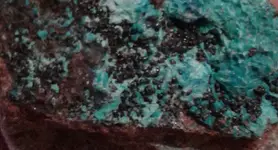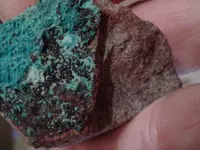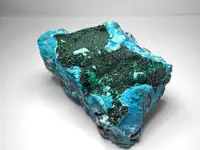You are using an out of date browser. It may not display this or other websites correctly.
You should upgrade or use an alternative browser.
You should upgrade or use an alternative browser.
What is it? little black cirlcles on turquoise I think
- Thread starter samko7804
- Start date
Sorry ! No one seems to Know in Here 
Try reposing in Our
Rocks/Gems
(10 Viewing)
A forum for rock hounds and gem hunters.
Talk about locations, techniques, finds, and more.
Hopefully Someone will Recognize it Soon.
By the way, Welcome to TreasureNet

Try reposing in Our
Rocks/Gems
(10 Viewing)
A forum for rock hounds and gem hunters.
Talk about locations, techniques, finds, and more.
Hopefully Someone will Recognize it Soon.
By the way, Welcome to TreasureNet

Last edited:
Upvote
0
No you havent done anything wrong, just no member who has answer. FYI non-members can view threads and posts but they cant post to reply unless registered. A lot of your views could be non-members who cant post.
Upvote
0
tamrock
Platinum Member
When it comes to rocks and minerals, knowing the actual source of where they came from is very important in determining what they can possible be. Gambrimus is correct imo, but malachite and chrysocolla have been found throughout the world. Those minerals are both found in many copper deposits. As for those little dark nodules, those could be a number of things. It's a pretty neat natural mineral specimen, so far.
Upvote
0
Gambrinus
Sr. Member
- Joined
- Dec 25, 2015
- Messages
- 313
- Reaction score
- 479
- Golden Thread
- 0
- Primary Interest:
- All Treasure Hunting
This is from the picture I provided regarding the black "circles."
"The malachites have small euhedral habits and form glisteninng ball-like clusters on top of the chrysocolla."
Thanks to tamrock's post I realized that was the question you wanted answered, maybe a smarter person than myself can explain in layman's terms what the definition of euhedral habits means.
BTW the specimen in the picture is from Africa.
"The malachites have small euhedral habits and form glisteninng ball-like clusters on top of the chrysocolla."
Thanks to tamrock's post I realized that was the question you wanted answered, maybe a smarter person than myself can explain in layman's terms what the definition of euhedral habits means.
BTW the specimen in the picture is from Africa.
Last edited:
Upvote
0
Older The Better
Silver Member
- Joined
- Apr 24, 2017
- Messages
- 3,634
- Reaction score
- 7,407
- Golden Thread
- 0
- Location
- south east kansas
- Detector(s) used
- Whites Eagle Spectrum
- Primary Interest:
- All Treasure Hunting
Rocks are very tricky to id from pictures holding them in your hands helps a lot, luster, weight, crystal habit, hardness, streak, are just hard to capture in a photo
If the little dark guys are octahedral they could be garnets
Otherwise I think the above Id is as good as any
I’ll take a stab at layman’s... minerals form in certain shapes, salt is always a cube, garnet are octahedrons, and so on... that is their crystal habit... euhedral just means clearly defined. So it’s just saying it forms in a clearly defined shape. in malachites case that can be little balls
If the little dark guys are octahedral they could be garnets
Otherwise I think the above Id is as good as any
I’ll take a stab at layman’s... minerals form in certain shapes, salt is always a cube, garnet are octahedrons, and so on... that is their crystal habit... euhedral just means clearly defined. So it’s just saying it forms in a clearly defined shape. in malachites case that can be little balls
Last edited:
Upvote
0
- Joined
- Dec 23, 2019
- Messages
- 6,334
- Reaction score
- 20,218
- Golden Thread
- 0
- Location
- Surrey, UK
- Primary Interest:
- All Treasure Hunting
Euhedral crystals are those which have a characteristically recognisable shape as a result of having multiple, well-formed, sharp faces. They typically crystallize in open environments where they are not cramped by anything which constrains their final shape. The opposite is ‘anhedral’ crystals, where there are no well-defined crystal faces in a recognisable shape and those form in environments where the crystal shape is constrained by crowding. For example crystals trying to form in magma (molten rock) as it cools may grow so closely together that they touch one another and there is then no free space for them to adopt a recognisable shape. When crystals fall somewhere between the two and have only a partially recognisable shape, we call them ‘subhedral’.
Small rounded crystalline habits like you’re showing have no sharply defined crystal faces but also have not been constrained. We wouldn’t regard them as either euhedral or anhedral. Their shape arises from forming around a tiny nucleus in layers, giving them a globular appearance, for which the proper geological term is ‘botryoidal’ (derived from the Greek word for a bunch of grapes). It’s a common crystal habit for hematite and a number of other minerals including malachite and chrysocolla.
Small rounded crystalline habits like you’re showing have no sharply defined crystal faces but also have not been constrained. We wouldn’t regard them as either euhedral or anhedral. Their shape arises from forming around a tiny nucleus in layers, giving them a globular appearance, for which the proper geological term is ‘botryoidal’ (derived from the Greek word for a bunch of grapes). It’s a common crystal habit for hematite and a number of other minerals including malachite and chrysocolla.
Last edited:
Upvote
0
Gambrinus
Sr. Member
- Joined
- Dec 25, 2015
- Messages
- 313
- Reaction score
- 479
- Golden Thread
- 0
- Primary Interest:
- All Treasure Hunting
Euhedral crystals are those which have a characteristically recognisable shape as a result of having multiple, well-formed, sharp faces. They typically crystallize in open environments where they are not cramped by anything which constrains their final shape. The opposite is ‘anhedral’ crystals, where there are no well-defined crystal faces in a recognisable shape and those form in environments where the crystal shape is constrained by crowding. For example crystals trying to form in magma (molten rock) as it cools may grow so closely together that they touch one another and there is then no free space for them to adopt a recognisable shape. When crystals fall somewhere between the two and have only a partially recognisable shape, we call them ‘subhedral’.
Small rounded crystalline habits like you’re showing have no sharply defined crystal faces but also have not been constrained. We wouldn’t regard them as either euhedral or anhedral. Their shape arises from forming around a tiny nucleus in layers, giving them a globular appearance, for which the proper geological term is ‘botryoidal’ (derived from the Greek word for a bunch of grapes). It’s a common crystal habit for hematite and a number of other minerals including malachite and chrysocolla.
Thanks. Euhedral didn't make sense to me but your calling it ‘botryoidal’ does. Although I like (a bunch of grapes) even better.
Upvote
0
Similar threads
- Question
- Replies
- 7
- Views
- 439
- Replies
- 22
- Views
- 1K
- Replies
- 2
- Views
- 479
Users who are viewing this thread
Total: 1 (members: 0, guests: 1)






